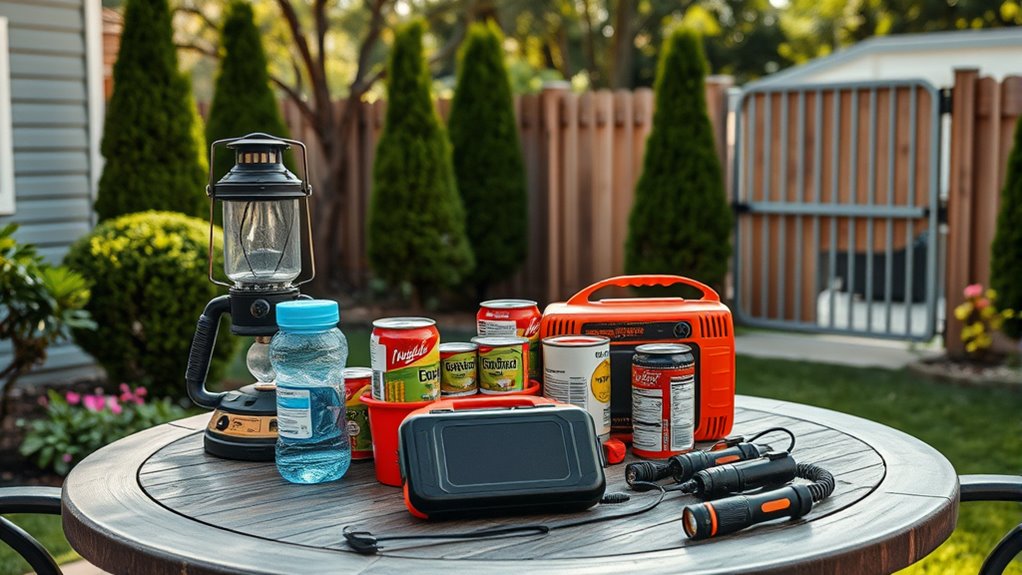To prepare for PSPS events, stay informed about fire risk alerts and weather conditions using utility notifications and local forecasts. Assemble an emergency kit with water, non-perishables, flashlights, and backup power for critical devices like phones and medical equipment. Create a communication plan with family and neighbors, and identify safe meeting points. Planning ahead ensures safety during outages—if you want to learn more, find out how to build a thorough wildfire preparedness strategy.
Key Takeaways
- Sign up for utility alerts to receive timely notifications about potential outages and fire risk levels.
- Assemble an emergency kit with water, non-perishable food, flashlights, batteries, and important documents.
- Develop and practice a family communication and evacuation plan, including meeting points and backup contact methods.
- Install backup power sources like portable generators or solar chargers for critical devices and medical equipment.
- Stay informed about weather conditions and fire danger alerts to proactively prepare and respond effectively.
Understanding the Reasons Behind PSPS Events

Understanding the reasons behind PSPS events requires recognizing that utilities deploy these outages primarily to prevent wildfires caused by electrical equipment. The concept began in 2008 when San Diego Gas & Electric requested permission from the CPUC, though it was initially denied. By 2012, regulators approved PSPS in high-risk weather conditions to reduce fire risk from energized power lines. Over time, rules expanded to include all investor-owned utilities, emphasizing safety and wildfire prevention. Utilities focus on managing electrical equipment, maintaining safe clearances from vegetation, and avoiding sparks from short circuits or molten metal. When weather becomes extreme—hot, dry, and windy—utilities preemptively shut off power to prevent sparks from igniting nearby vegetation. These decisions aim to protect communities while balancing safety, reliability, and wildfire risk mitigation. Enhanced safety protocols have also been incorporated to ensure swift response and minimize outages during emergencies.
Monitoring Weather Conditions and Fire Risk Alerts
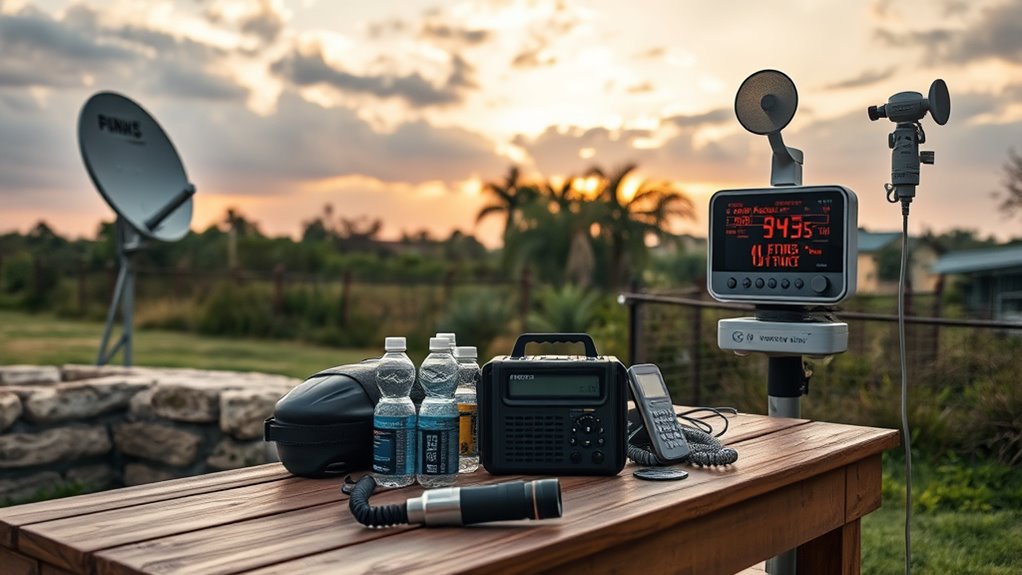
You need to stay alert to weather updates and fire risk warnings, especially during high wind and low humidity conditions. Sign up for alerts from your utility and local agencies to get timely notifications about potential PSPS events. Understanding fire risk levels helps you prepare and respond effectively when conditions worsen. Monitoring PSPS Areas by Island can help you identify if your community is at higher risk during wildfire threats. Additionally, being aware of fire risk levels can guide your readiness and safety measures during peak wildfire seasons. Recognizing the importance of air purifier features and technology can also support your health by reducing indoor allergens and smoke particles during smoke events. Being familiar with natural environment characteristics can also help you better understand how local flora and fauna may influence fire behavior and risk. Staying informed about essential oils for respiratory health can provide additional relief if smoke infiltrates your indoor environment.
Track Weather Developments
Monitoring weather conditions is a critical step in evaluating wildfire risks and determining the need for public safety power shutoffs. You should rely on real-time data from utilities’ meteorologists and fire scientists who track wind speed, temperature, and humidity. Local weather stations provide localized insights, while forecasts from agencies like the National Weather Service issue Red Flag Warnings for high fire danger areas. Continuous ground observations help identify sudden changes such as high winds or dry conditions. Situational awareness teams stationed in High Fire Risk Areas monitor environmental shifts closely. Weather data collection is essential for timely and accurate decision-making. To stay ahead, focus on these key factors:
- Track wind speed and gusts
- Observe humidity levels
- Monitor temperature fluctuations
- Watch for rapid weather changes
- Stay informed about advanced materials used in wind turbine blades, which can influence the resilience of infrastructure during extreme weather events. Incorporating knowledge of fire-resistant building materials can also be vital in assessing overall community safety during wildfire threats. Additionally, understanding the impact of climate change on weather patterns can help in long-term planning for wildfire preparedness and infrastructure resilience. Being aware of changing climate conditions is crucial for adapting strategies and enhancing community resilience over time.
These steps help inform timely decisions for public safety.
Sign Up for Alerts
Staying informed about fire risks and weather conditions is essential for effective wildfire preparedness, and signing up for alerts guarantees you’re notified promptly. Create or update your online accounts with utility providers like SDG&E, PG&E, or PNM to receive alerts via text, email, phone calls, or app notifications. Even if you don’t have an account, you can still sign up through utility apps or public platforms. Make sure your contact information is current to avoid missed alerts. Utilities also offer tailored notifications for those with medical needs, living in rural areas, or requiring language assistance. Alerts are sent out in advance—usually 48 hours before a potential outage—and continue during and after the event. This consistent communication helps you stay prepared and respond quickly to PSPS events.
Understand Fire Risk Levels
Understanding fire risk levels requires paying close attention to weather conditions and fire danger alerts, which are essential for wildfire preparedness. Monitoring real-time data helps you stay aware of potential hazards and when to prepare for PSPS events. A recent breakthrough in AI research has even enabled the manipulation of quantum particles, which could revolutionize how fire risk is predicted and managed in the future. Monitoring these fire danger alerts can also be enhanced by AI-driven systems that analyze vast datasets more efficiently. Additionally, leveraging cybersecurity measures in these AI systems ensures the integrity and accuracy of the data used for fire risk assessment. Incorporating advanced data analysis techniques can further improve the precision of fire risk predictions, enabling more proactive safety measures. Staying informed about weather patterns and their impact on fire risk is vital for effective wildfire preparedness.
Creating an Emergency Kit and Survival Plan
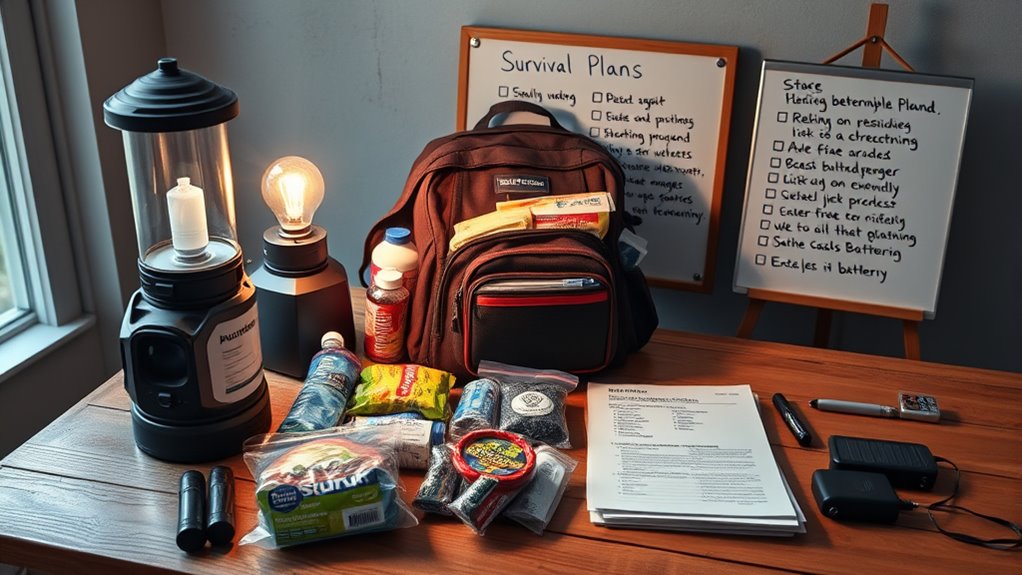
To stay prepared during power shutoffs, you need an emergency kit with essential supplies, backup power options, and a clear family communication plan. These elements help you respond quickly and stay safe when outages occur. Building and practicing this plan guarantees everyone knows what to do and where to locate what they need. Additionally, understanding long-term comfort options like quality recliners and massage chairs can provide relaxation and relief during stressful times. Incorporating portable camping gear like compact tents and portable toilets can also be useful if you need to evacuate or spend extended periods away from home. Proper load‑planning and having a reliable backup power source ensure your essential devices stay operational during outages, providing peace of mind. Planning for emergency communication devices ensures your family stays connected even when traditional networks are down.
Essential Emergency Supplies
Creating an effective emergency kit and survival plan guarantees you’re equipped for power shutoffs and other emergencies. To guarantee you’re prepared, gather essential supplies that can sustain your household.
- Stock at least one gallon of water per person daily for three days, rotating supplies regularly for freshness.
- Keep non-perishable foods like canned goods, energy bars, and manual can openers on hand.
- Have flashlights with extra batteries and a rechargeable or crank radio accessible for updates.
- Store important documents and emergency cash securely, and keep copies of crucial medical and contact information.
Having these essentials ready helps you respond swiftly, stay safe, and maintain basic needs during power outages. Regularly check and update your supplies for ideal preparedness.
Backup Power Solutions
Having the right backup power solutions in place guarantees you can maintain essential functions during power shutoffs. Portable power stations are ideal for indoor use, powering devices like phones, laptops, fans, and CPAP machines safely. Dual-fuel or gas generators offer strong power but must be used outdoors, away from windows, for safety. Solar generators, combining batteries and panels, provide quiet, clean energy during nighttime outages and extend power availability. Regular testing of your equipment ensures it works when needed. Your kit should include extension cords, surge protectors, extra batteries, and safely stored fuel if using gas generators. Prioritize backup power for critical medical devices, and incorporate portable solar panels to maximize renewable energy. Understanding how arcade machines operate can help you better maintain and troubleshoot your backup systems. Proper planning and maintenance guarantee reliable backup power during PSPS events, and being familiar with emergency power planning can further enhance your preparedness. Additionally, familiarizing yourself with power system safety protocols is essential to prevent accidents and ensure safe operation of backup equipment. Maintaining a well-organized emergency kit with all necessary components can significantly reduce stress during outages.
Family Communication Plans
How can your family stay connected during a power outage? Establishing a communication plan is key. First, assign roles so everyone knows their responsibilities during emergencies. Second, develop contingency plans for different situations—day or night, weekday or weekend. Third, keep updated contact info for workplaces, schools, and caregivers. Fourth, designate an out-of-area contact to relay messages if local networks fail. Regularly test family group chats or messaging apps to ensure quick communication. Share meeting points—like community centers or parks—and rehearse reaching them. Keep copies of important documents offline and online, and include emergency kits tailored to your household’s needs. Additionally, understanding your family’s family background can help tailor communication strategies that are culturally sensitive and effective. With these steps, your family can stay informed, coordinated, and safe during PSPS events.
Ensuring Power Backup for Critical Devices

Ensuring your critical devices stay powered during Public Safety Power Shutoffs (PSPS) requires choosing reliable backup options and testing them in advance. Portable lithium-ion power stations are a safe, indoor-friendly way to power essential electronics like medical devices, phones, and laptops. Dual-fuel or gas generators deliver strong power but must be used outdoors, away from windows, due to carbon monoxide risks. Solar generators with battery storage offer quiet, clean energy, especially when paired with daytime solar charging. Regularly testing your backup systems guarantees they’re operational when needed. Keep supplies like extension cords, surge protectors, and safe fuel storage on hand to maximize safety and usability. Proper preparation guarantees your critical devices remain functional and protected during outages.
Communicating With Family and Neighbors
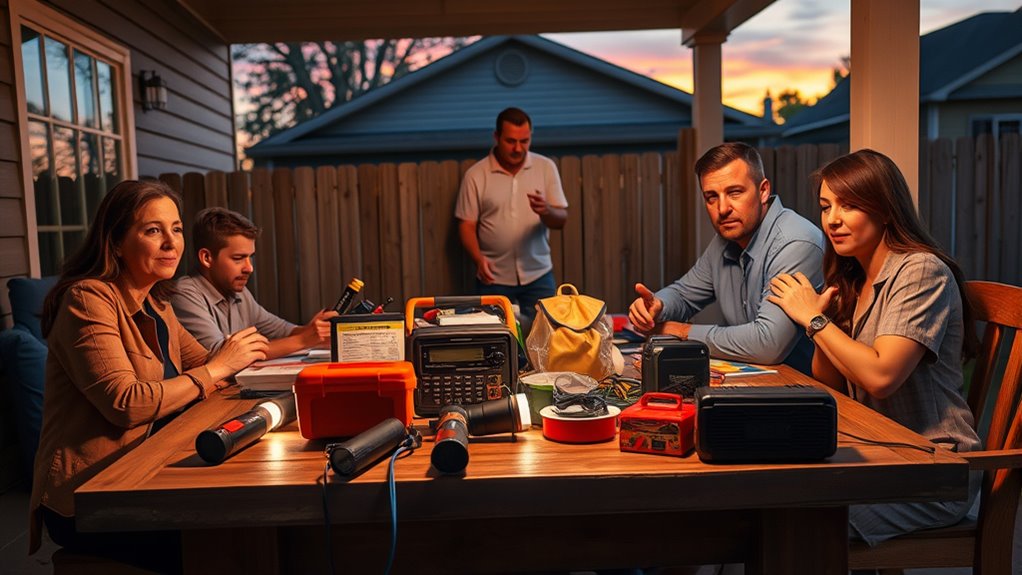
Effective communication is essential during Public Safety Power Shutoffs, especially when coordinating with family and neighbors. To stay connected and informed, consider these steps:
- Identify primary contacts and agree on communication methods like phone trees, social media groups, or text chains to ensure quick alerts.
- Develop a plan to share regular updates before, during, and after outages, keeping everyone aware of safety measures and status.
- Create a roster of vulnerable individuals needing extra help or check-ins, and establish designated meeting points or call-in times if usual channels fail.
- Use simple language, visual aids, and gestures to minimize misunderstandings, especially when stress levels are high or communication is hindered.
Staying Informed During Power Outages
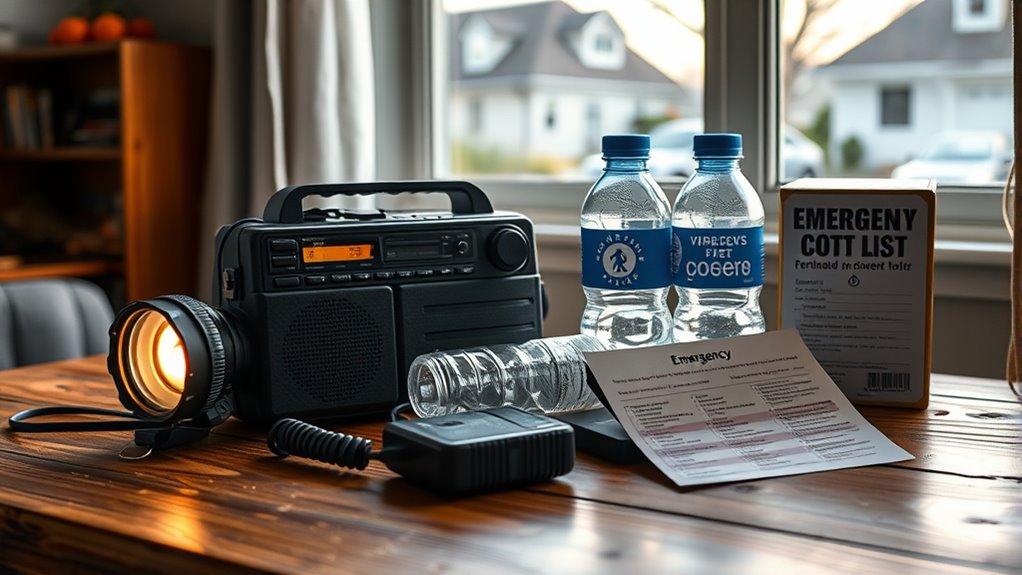
Staying informed during power outages relies on timely updates from utility providers and local authorities. Keep your contact information current to receive alerts via phone calls, texts, emails, social media, and website updates. Some utilities offer real-time outage maps showing affected areas and restoration progress, which can help you plan accordingly. Be aware of alert categories: a Watch signals a potential shutoff, while a Warning indicates an imminent outage. During rapidly changing wildfire conditions, notices may be minimal or absent. Use utility apps, social media, and hotlines for the latest info. Register for special status programs if needed, and make sure your communication preferences are set. Staying connected through multiple channels ensures you stay informed and prepared during PSPS events.
Post-Outage Safety and Restoration Tips

After power is restored, it is crucial to prioritize safety by inspecting electrical systems and checking for line damage. Power lines are thoroughly inspected after high-risk weather to ensure safety before resuming service. Crews look for equipment damage caused or worsened by extreme conditions like wind or fire risk. Restoration only happens once inspection teams confirm the system is safe. This process can take hours or days. To stay safe, follow these tips:
- Wait for official clearance before turning on appliances.
- Turn on only essential devices first to prevent overloads.
- Keep at least one light on during restoration to detect power return.
- Avoid using damaged or sparking lines and report any issues immediately.
Following these steps helps prevent accidents and fire hazards during the post-outage phase.
Frequently Asked Questions
How Often Do PSPS Events Typically Occur in My Area?
You can expect PSPS events in your area to happen about 4-5 times per year if you’re in high fire threat districts like Kern, Los Angeles, or Ventura Counties. These outages often coincide with hot, dry, windy weather during peak wildfire season, usually late summer to early fall. Keep in mind, the exact frequency varies based on local conditions, but frequent outages are common in high-risk zones.
What Are the Signs That a PSPS Might Be Imminent?
You’ll notice weather warnings like red flag alerts, indicating high fire risk with strong winds, high temperatures, and low humidity. Utility companies often send alerts 48 hours and 24 hours before a potential PSPS, so stay attentive to these notifications. Also, watch for signs like dry vegetation near power lines, increased wildfire activity locally, or utility reports of high electrical stress. These signs suggest a PSPS could be imminent, so stay prepared.
How Can I Find Out Which Circuits Will Be Affected?
You can find out which circuits will be affected by checking utility-provided outage maps online, which update in near real-time. Contact your utility’s customer support or visit their website for detailed circuit information, tailored alerts, or notifications specific to your address. Some utilities also send direct alerts or emails based on your location. Keep an eye on community alerts and official updates during wildfire risk periods for the latest circuit impact info.
What Safety Precautions Should I Take During a Power Outage?
Wondering how to stay safe during a power outage? You should keep flashlights handy and avoid candles to prevent fires. Use battery-powered radios to stay informed, and conserve your phone’s battery with backup power sources. Don’t try to use electric gates or elevators—know how to operate them manually. Stock up on water and nonperishable food, and make certain medical devices have backup power. Staying prepared helps you handle the outage safely.
How Long Do PSPS Outages Usually Last?
PSPS outages typically last 1 to 2 days, but they can extend beyond that, especially in northern counties like Butte, Madera, and Mariposa, where outages sometimes last over a week or even a month due to weather or infrastructure damage. Keep in mind, the duration depends on weather conditions, repair needs, and safety assessments. Staying prepared for outages of several days helps guarantee your safety and comfort.
Conclusion
By staying informed and prepared, you’ll find that even unexpected PSPS events become manageable moments rather than crises. Sometimes, a simple checklist or a quick chat with neighbors can turn a potential challenge into an opportunity for community connection. Remember, the key is to remain adaptable and alert—because just when you think you’ve covered everything, nature reminds you of its unpredictable dance. Your readiness today shapes a safer, more resilient tomorrow.

